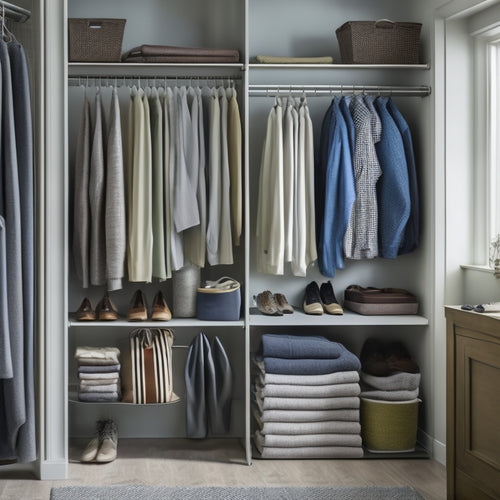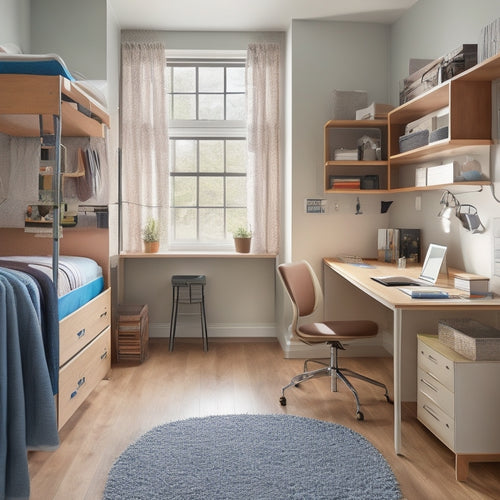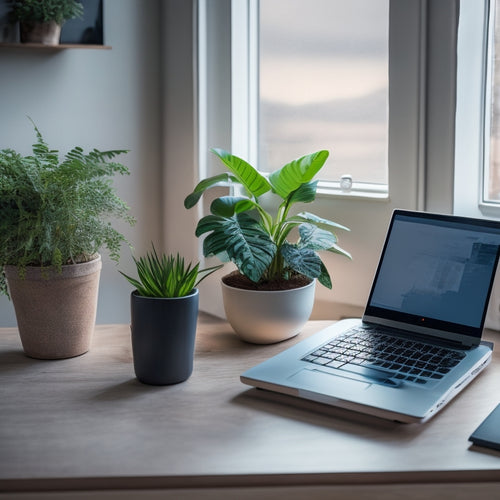
Declutter and Organize Your Home in 5 Steps
Share
To declutter and organize your home in 5 steps, start by purging unwanted items completely, sorting them into "keep," "donate/sell," and "discard" boxes. Next, categorize and group similar items, using labeling systems to maximize space. Then, assign a home for each item, allocating convenient spots for frequently used items. After that, designate zones for better flow, dividing your space into functional areas. Finally, maintain your organized space by setting aside time each day to tidy up and scheduling seasonal refreshes. Now, get ready to uncover the secrets to a Stress-free Space.
Key Takeaways
• Purge unwanted items by removing broken, outdated, or unused items and letting go of emotional attachment to create space.
• Categorize and group similar items together, using labeling systems and storage hacks to maximize space and accessibility.
• Assign a designated home for each item, allocating convenient spots for frequently used items and utilizing storage solutions like baskets and bins.
• Designate zones for better flow by dividing space into functional areas, identifying areas for specific purposes, and mapping out daily routines.
• Maintain your organized space by setting aside time each day to tidy, scheduling seasonal refreshes, and putting away items out of place regularly.
Purge Unwanted Items Completely
Begin by gathering three boxes or bins labeled 'keep,' 'donate/sell,' and 'discard,' and then systematically go through every room in your home, removing everything that's broken, outdated, or no longer serves a purpose. This is the first step towards decluttering and organizing your home. Be ruthless – if you haven't used it in the past year, it's probably safe to get rid of it.
Let go of emotional attachment to items that no longer bring you joy or serve a purpose. Remember, sustainable living is about living simply and mindfully.
As you sort through your belongings, ask yourself: 'When was the last time I used this item?' or 'Does it still have a purpose in my life?' Be honest with yourself, and if the answer is no, consider donating or discarding it. Don't worry about the sentimental value – take a photo of the item and let it go.
Categorize and Group Similar Items
Now that you've purged your unwanted items, sort what's left into categories, grouping similar items together, such as all cleaning supplies in one area or all books on a specific shelf. This will make it easier to see what you have and where it should go.
Create labeling systems to identify each category, like 'Kitchen Utensils' or 'Bedroom Linens'. This will help you and others quickly find what they need.
As you group similar items, think about storage hacks to maximize your space. For example, use stackable bins to store out-of-season clothing or install shelving units to keep books organized.
Consider vertical storage options, like wall-mounted hooks or baskets, to keep items off the floor and out of the way.
Assign a Home for Each Item
Assigning a designated spot for each item is essential in keeping your space clutter-free and organized. This step is vital for maintaining your newly organized space.
Start by identifying the items you use frequently and allocate a convenient spot for them. For instance, designate a specific drawer or shelf for your kitchen utensils, and another for your cleaning supplies.
Labeling systems can be a great help in this process. Use labels or stickers to identify what's inside a container or on a shelf. This way, you'll know exactly where to find what you need, and you'll be less likely to misplace items.
Storage solutions such as baskets, bins, and shelves can also help keep items organized and out of sight. Remember to keep similar items together, and store them in a way that makes sense for your lifestyle.
Designate Zones for Better Flow
By dividing your space into functional zones, you'll create a more efficient flow that streamlines your daily routines and reduces clutter. This means identifying areas that serve specific purposes, such as a homework station, reading nook, or cooking zone. By doing so, you'll create a functional layout that supports your lifestyle and traffic patterns.
Start by mapping out your daily routines and identifying the areas where you spend most of your time. Consider the flow of traffic in your home, and allocate zones accordingly.
For instance, if you have a busy morning routine, designate a zone near the entrance for keys, wallets, and bags. Similarly, if you love to cook, create a zone near the kitchen for meal prep and cooking utensils.
Maintain Your Organized Space
To keep your newly organized space from reverting to chaos, set aside a few minutes each day to maintain your zones and guarantee everything stays in its designated place. This daily habit will help you stay on top of clutter and make sure your space remains functional and peaceful.
Start by dedicating a specific time each day, such as right after breakfast or before bed, to tidy up and put away any items that are out of place.
As you maintain your space, remember to also schedule seasonal refreshes to keep your zones in check. This might mean switching out seasonal decorations, reorganizing your closet, or deep cleaning high-traffic areas.
Frequently Asked Questions
How Do I Deal With Sentimental Items That Are Hard to Part With?
When dealing with sentimental items, you're not alone in feeling an emotional attachment. Create memory boxes for select items, allowing you to keep memories while letting go of the rest, and practice self-compassion throughout the process.
Can I Get My Family Members to Help With the Organizing Process?
When asking family members to help, consider your family dynamics and set clear personal boundaries to avoid conflicts. Be specific about tasks, delegate effectively, and show appreciation for their efforts to guarantee a collaborative process.
What if I Have Limited Storage Space in My Home?
You'll need to get space savvy when dealing with limited storage space. Focus on vertical maximization by using stackable containers, wall-mounted shelves, and hanging organizers to make the most of your available space.
How Often Should I Schedule Maintenance to Keep My Space Organized?
"Savvy separator, schedule seasonal refreshes every 3-4 months to maintain momentum, while cultivating daily habits like the 'one-touch rule' and 10-minute tidies to keep your space sparkling and stress-free."
Are There Any Specific Organizing Tools or Products That I Need?
You'll need some essential tools to maintain your organized space. Invest in a label maker to categorize items, and shelf dividers to separate clutter-prone areas, ensuring everything stays in its assigned place.
Related Posts
-

Why Double Rods Are Key to Small Closet Organization
By installing double rods, you can instantly double your storage capacity and open up a more organized, clutter-free ...
-

10 Essential Storage Hacks for College Dorms
You'll need to get creative with storage to make the most of your college dorm room's limited space. Start by maximiz...
-

Declutter Your Desk With These Online Tutorials
You're just one organized desk away from boosting your productivity, reducing stress, and achieving a sense of contro...


